#xenosaga spoilers
Text

i've reached the end of xenosaga episode III
#xenosaga spoilers#IF ANYONE CARES????#kos-mos#xenosaga#xenosaga episode 3#saga incorrect tweets#these are fun to make maybe i'll do more eventually#for me and the other five saga fans out there#:salute:
4 notes
·
View notes
Note
Xenoblade 3 has Na'el and Alpha similar to Shulk and Zanza. In addition, Z is a sort of system with an entire collective unconscious.
We added Na'el and Alpha.
Going to leave Z out though because not only does the wiki not mention this connection (it is said he is an AI that was created that then became self aware and went batshit), but in Xenosaga where the collective unconscious gets actual focus its just the manifestation of the subconscious of all of humanity past and present as one unknowable eldritch force thing that is sorta God.
The point is that its all fused into one will from all(most of) those who have died previously. That is less 'more than one' and more a fusion thing where the entities involved Are one person with no separate sense of self as far as the actual game goes and not whatever was stuffed in Perfect Works.
One could argue this is the case FAR more with Willheim than Z considering his whole deal, but even then Willheim is really not displaying 'more than one' experiences he was just 'created' by The Collective Unconscious to continually hit the reset button on the earth(eternal recurrence) so thats why he isnt in the xenosaga entry -he has no indication he exists in any way but as a singular entity.
#blog chatter#disclaimer we did not finish xc3 because we Did Not Like It At All but the wiki is Usually fairly accurate and we arent seeing it So#xc3 spoilers#future redeemed spoilers#xenosaga spoilers
5 notes
·
View notes
Text
I still can't get over the fact I watched Xenosaga while waiting for Xenoblade 3 to come out and it became relevant.
#future redeemed#xenoblade 3 dlc#future redeemed spoilers#xenosaga#xenosaga spoilers#????#raven rambles#hey its raven#the timing lol#if you look at the time lines of both compaired to earth merging safely#everyone from both are gonna be alove to meet#well the 1 and 2 cast and the kids so base game 3#i'm a little worried about dunban due to Shulk's wording and his age plus permanent injuries#cross our fingers hes okay though#that fucking radio though#if you wanna actually hear me talk about it fully i can probably drop a link to the stream vod of the dlc final.#and me and my partner are starting a Xenoblade 1 revist playthrough where we're gonna talk about implications
8 notes
·
View notes
Text
the xeno series really said "anyone named jin will wield a sword and also FUCK them"
#skylar talks#xenosaga#xenoblade#xenoblade chronicles#xenoblade chronicles 2#xenosaga spoilers#xenoblade spoilers#xenoblade chronicles spoilers#the tragic jins my beloved
4 notes
·
View notes
Text
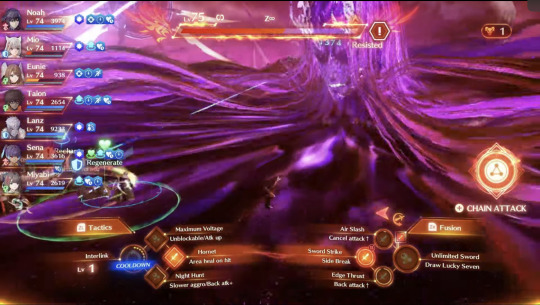
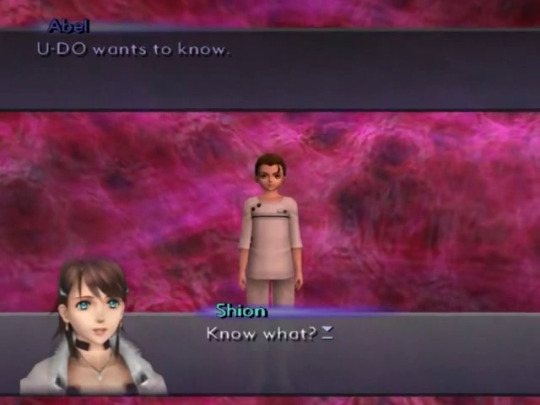
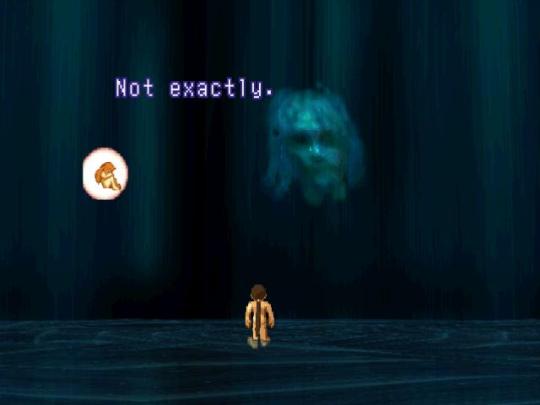
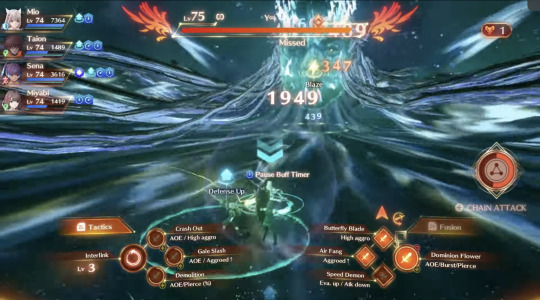
Yeah ok
12 notes
·
View notes
Photo

So...um...Chapter 7 of Episode III was a lot...
#aka 'shion's terrible horrible no good very bad day'#i was literally yelling at the screen to give her a freaking break#and that's just disc 1?!#what will this poor woman go through next?!#every party member in this game needs therapy#xenosaga#xenosaga spoilers#xenosaga memes#xenosaga episode iii#shion uzuki
30 notes
·
View notes
Text
Top 5 Best Villains
5. Ramsus (Xenogears)
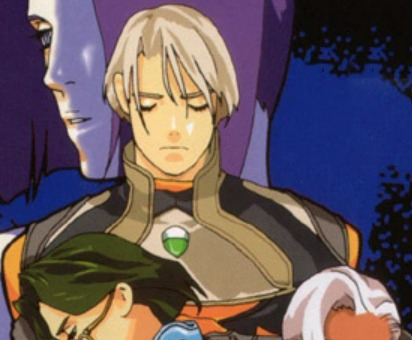
I’m going to admit to not entirely remembering Xenogears’s story, but Ramsus was my favorite antagonist there. The problem with most villains in the game are that their most important content happens in disc 2, which is too abbreviated and difficult to follow to properly sell their impact. Overall, Xenogears is a game heavily bogged down by its complexity. It was ultimately both too ambitious for the skill and resources of its creators, which results in a story that presents interesting ideas but is also clumsy and difficult to follow.
Like, many characters, he is a strong concept with a difficult to follow execution. He is a general of Solaris, which are functionally Nazis, while still trying to follow his ideals. He spent his childhood being groomed by the people running Solaris to hate Fei because of lore reasons. So, he’s conceptually meant to be a good person who was raised from birth to be a commander in a fascist government. In practice, Rammus is primarily a Disc 1 antagonist, who starts off intimidating but the player learns about his past over time and starts to sympathize with him. Ultimately, the execution is clumsy and difficult to follow, but his concept always stuck with me.
He also acts as a counterpart to Elly, who is also a soldier from Solaris who ultimately defects. I honestly don’t remember if this idea is even explored because Rammus’s backstory is mostly revealed in Disc 2, which summarizes and skips over a lot of stuff.
Overall, you can probably tell from this that I don’t have the same respect for Xenogears as a lot of its fans, but the main thing that elevated Ramsus over other major antagonists was that I was able to understand the major story beats of his character before consulting the wiki. The only other antagonist to accomplish this was Id, but I wanted to talk about Ramsus because Id barely has the chance to do anything because he’s primarily a disc 2 character.
4. Dickson (Xenoblade Chronicles)

Dickson is a really well done twist villain. He’s primarily a scumbag with shallow motives, but he makes up for it by his plot presence. His VA does an amazing job selling him as enjoying himself but not completely off from the Dickson we knew before that point. He treats the affair of betraying the party like a business as usual ordeal where he just enjoys his job.
He does a lot of heavy lifting in setting the game’s final act, beginning it by killing the game’s protagonist and talking about how he only raised Shulk because he was Zanza’s vessel. Before this point in the game, Dickson was a secondary character who was somewhere between a dad, a jokester, and a cheesy action hero. He effectively goes from being a fun side character to being a fun fuck-you villain. Out of the Zanza-aligned antagonists, Dickson is the only one with an established personality, so leading this act with him shooting Shulk kicks off the final quadrant which is defined by fighting former friends and loved ones, betrayal, and everything the characters knew about the world coming crashing down.
As an antagonist, Dickson is pure evil. No redemption, no mind control, nothing; he does what he does because he does. This hurts because he’s a likeable character, therefore you want him to be redeemable, but he simply isn’t. As a side note, while I don’t think Dickson did the most subtle job at foreshadowing his eventual betrayal, I do think he did a good job at ensuring that this act didn’t come out of literally nowhere, which is the most important thing. Xenoblade chronicles has a lot of foreshadowing in the form of off-handed dialogue, especially placed in the earlier parts of the game, which works for Dickson because even if the player catches on that Dickson is deceiving the party in some way in Satorl Marsh, his betrayal is so much later in the game that there’s a high chance of the player forgetting it. The moment before he shoots Shulk is also great. There’s just enough timing for dread and anticipation to crop up right before he shoots on second viewing.
Dickson’s death was also perfect for the character. He isn’t redeemable, he’s been lying to you this entire time. Despite it all, he did watch the protagonists grow strong enough to beat him. So, his send-off is bitter-sweet. I like how Shulk cries while walking into the portal to fight Zanza. I also like how Dickson calls off the fight when he’s dying and goes to die in a corner and take a smoke. Even though he’s ultimately a piece on Zanza’s chess set, he still got to choose how he wanted to die, a right afforded to him by Shulk, who is fighting to end everyone’s predetermined destinies.
He’s a simple antagonist that could have benefitted from more complications, especially from Shulk’s or Dunban’s part, but he fills his role in the story well for what he is.
3. Kevin (Xenosaga)

Warning: abuse mention
Kevin is interesting to me because he’s such a shitbag. Like, holy shit the amount he emotionally manipulates Shion is ridiculous. I think the Xenosaga series has issues with the concept of restraint, but it really works here. He also acts as a foil to Allen, where Kevin is trying to save Shion from her fate but does so by emotionally scarring her, Allen cares a lot about Shion and wants to protect her but cannot.
He’s first introduced in Xenosaga Episode I as the primary motivator for her to complete KOS-MOS. She was their project and even though KOS-MOS killed him due to a malfunction, Kevin would have wanted her to finish their project. Shion treats KOS-MOS almost like her child because of it. The player doesn’t learn that he faked his own death until Episode III, where its first primary conflict is KOS-MOS being scrapped in favor of T-ELOS, an android created from KOS-MOS with significantly higher output, which is secretly run by Kevin. By this point in the series, KOS-MOS has established herself as somewhere between a person and a weapon, effectively having a soul, so killing her isn’t going to fly. This also reflects on how Kevin is more than happy to take Shion’s feelings and throw them into the garbage dispenser just to advance his own goals. Which is contrasted by how much Shion obviously loves him. She was willing to complete and defend his legacy in spite of her own mixed feelings because of how much she loves him.
The protagonists of Xenosaga can be defined as being weak but human, while Kevin made the decision to give up his humanity to become strong. This weak but human dynamic is most represented in Allen, who is literally just some guy, but he cares a lot about Shion and even though he’s so nothing, he’ll always try to stay by her side. Allen cannot save Shion from her death, he cannot save the universe from collapsing in on itself, he can’t protect Shion from her trauma, but he’s still there doing every limited thing that he humanly can. Kevin can save Shion from her death, he’s working to prevent the universe from destroying itself, he can do so many things that a human like Allen could never hope to do, yet he’s still a self-serving bastard. He isn’t trying to save Shion because she wanted to be saved, he’s doing so because he wants to save her. And his methods are a major source of trauma for her. Watching him, it becomes unclear whether he even truly cares about her.
Kevin’s also an extension of the themes KOS-MOS vs T-ELOS represents between materiality and spirit. KOS-MOS was created by Shion in memory of a dead loved one and holds Mary Magdalen's soul, while T-ELOS was created by Kevin for the sole purpose of housing Mary Magdalen’s body. Which is reflected in how the two characters see the world. Shion is a very emotional character. She sees the life and value in what exists around her. Kevin, on the other hand is a very material heavy character, he sees the world only in terms of what does and does not exist. So of course Shion’s creation would house a soul while Kevin’s would only house a body. This theme of soul vs material is extremely common in Monolith’s writing and it’s very present here as well.
What I like about Kevin’s story is how messy it is. The story is told almost entirely from Shion’s perspective. Her rose-tinted lens of the man. As the player, it’s hard to know whether he’s a genuinely good person making bad decisions or the biggest pile of dicks to exist ever. But ultimately, through all the feelings of love or any of his stated intentions, he abused Shion. At the end of the series, he sacrifices himself. Whether he did so to protect Shion or for redemption, it’s up to interpretation. I honestly cannot tell whether or not he’s meant to be sympathetic, and I like that because it just adds to the mixed feelings the character leaves you with.
The character being so difficult to get a read on works because that’s how abuse works. Victims of abuse will have a hard time realizing that they’re being abused until it’s too late, they’ll side with their abusers, they’ll see them as good people and make excuses for them, even when they act inexcusably because on some level, abusers are human beings and their victims know this. A lot of stories that cover abuse struggle to really get this aspect of it correct. Usually them being an abuser will be signposted to the audience way before the characters, which makes the character’s sticking with them look like poor judgement rather than what it actually is. Kevin is unique because his hands are never fully revealed, so even after his true death, the player is left without a clear direction on him.
2. Lao (Xenoblade Chronicles X)

Warning: Suicide Mention
Lao starts off as a party member, who then betrays the party for the Ganglion. He is the main focus of the game’s strongest story beat. Lao is a hero villain. He is also the first in a series of villains in the series who is beaten down by despair and opposes the party out of a suicidal desire rather than a malicious one. I personally am not a fan of the villains who want to kill the world because they are suicidal because that explanation doesn’t make a ton of sense to me. Generally when someone wants to kill themselves, it comes from a sense of deep hopelessness and wanting a way out. I’m not saying that it’s always the case, but these villains are typically presented as destroying the world out of a sense of hopelessness. So, I’m left confused on why these antagonists chose to kill the world rather than just themselves. Ultimately, characters like Jin and N feel like they’re trying to imitate Lao without truly understanding why he worked.
As an antagonist, Lao’s value is derived almost entirely from his motives. In Xenoblade X, you should be playing the sidequests experience the full story, so you have likely already encountered evil human characters or characters colluding with the Ganglion, especially if you’ve completed Hope’s second affinity mission. What makes these characters different from Lao lies in their motives and thematic purpose. The human NPCs in X are complex as a whole, each having their own subtly different takes on the events of the game. Earth’s destruction, mimeosomes, etc. They exist to show the complexities of humanity. How some people will do everything they can for the greater good while others will act selfishly, even when it’s to the detriment of both their own and everyone’s survival. Which are how these side-quest antagonists typically fit into X’s themes. As a suicidal character, Lao is not unique either. Throughout affinity missions and NPC dialogue, you learn that many human characters feel disassociated in their mimeosome bodies. Either seeing themselves as not real or expendable. Which is only compounded with by witnessing their friends and loved ones die with the earth.
Lao exists as a combination of ideas already presented in side-stories. He wants to die and he knows that dying can’t be permanent because of the stasis created by the mimeosomes. Even if he took his own life, he’d just be brought back in another mimeosome. It would be an endless cycle. Thus, it would easier to just tear everything to the ground than to go on living in these empty bodies dying over and over again just to protect the parts of humanity least worth saving. All he has to do is steal a piece of data, run, and wait for the clock to go out. His motives become more thematically appropriate upon learning the context of Chapter 12.
On his own, Lao provides an interesting perspective on everything. So much of X is about how humanity intends to survive after losing everything. Elma is the character most representative of this. Her sole focus is the survival of humanity. Lao asks if humanity is worth saving. After all, it would be easier to just accept death than fight this uphill battle. Which is what the conflict between him and Elma is fundamentally about. You could say during this fight, the protagonists represent fighting for humanity’s survival while Lao is fighting for humanity’s soul. That’s also why he gives up on his goal upon seeing Lin stopping Elma from shooting him. Because she proves that humanity still has a soul. It is also why he acts the way he does during Chapter 12, if humanity is worth protecting, he will protect it. The final fight with Lao isn’t about the opposition between humanity’s survival and, well, humanity, it’s about overcoming the ugliest parts of humankind to pave a way towards the future; a sweltering uncontrolled amalgamation that just wants to survive and die and aimlessly destroy where one consciousness has no hope of ever directing the mass of disfigured beings.
The fight against Lao during Chapter 11 is one of the most thematically dense moments in the series, especially among the more recent games. I’ve already talked about how Elma represents survival no matter the cost while Lao represents the cost itself. But the actual details of their debate says a lot about both Lao’s and Elma’s characters. To Elma, there is no such thing as a soul, rather the human experience can be surmised as a collection of one’s memories. There is very little variance between human to human, after all, the DNA of two people on opposite sides of the Earth are functionally identical. Thus, factors like race, class, age, etc. weren’t things she saw as important to consider when it came to archiving the human experience and, in more practical terms, who was worth saving. Lao argued that because she ignored those things, only the worst of humanity escaped Earth’s annihilation. It doesn’t matter if those issues aren’t logical, humans will still do it anyways. The only survivors from Earth were the ultra wealthy and the military. What about the people who were neither rich nor useful? The homeless, the poor, the disabled, the young, the elderly, his family. This isn’t humanity. Lao challenges the very reason you’re trying to save the human race from extinction.
Then there is Lin, the sole child to survive human extinction. She represents everything humanity is meant to protect. Though she was only brough aboard the White Whale because of her engineering talents, she is humanity’s future. Lao recognizes this. While Elma treats Lin as an adult, entrusting her with a world of responsibilities, Lao sees her as the kid she is. For her, he puts aside his depression and takes care of her in whatever capacity he can. He takes her out for tea, he jokes with her like an uncle, he keeps an eye out for her wellbeing. Even when he’s seeking to destroy the human race, he’s still trying to protect her from his hopelessness.
Lao is the climax to Xenoblade X’s themes. An interesting villain with easily understood motives hiding a lot of depth. He acts as a foil to the two protagonists, giving them a lot more depth. Elma in particular really shines during the Lao fight because he challenges everything she stands for.
1. Metal Face (Xenoblade Chronicles)
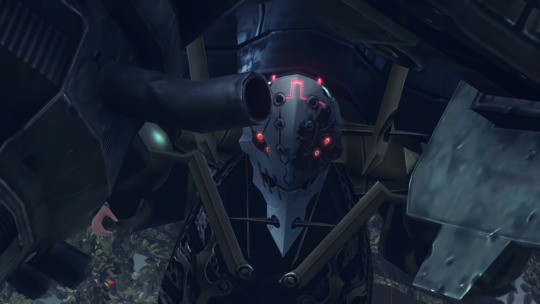
Metal Face is a pure fuckboy villain, and he leaves a glorious first impression. He has the perfect combination of amusing and terrifying, ending his run as pathetic. He establishes the Faced Mechon and the mechon as a whole as malicious and threatening, which sets the scene perfectly for every mechon-related villain after him.
The reason he’s able to establish himself as a threat so quickly and effectively is that his first two encounters consist of him taking the protagonists down a notch. During his first encounter, you just got the Monado and just obtained some way to fight the mechon, only for this one mechon to appear that cannot be damaged by the Monado and then said mechon proceeds to kill an established party member. Metal Face’s decision to leave doesn’t appear to be caused by the protagonist’s actions either. In all of Shulk’s rage and Fiora’s desperate final stand, they were only able to scratch him. The second time Metal Face shows up, he doesn’t even fight you, he only taunts you. This time, he appears right after Xord’s death, which establishes that the Faced Mechon are not invincible. Metal Face uses this time to reestablish the Faced Mechon’s threat and to undermine any growth the protagonists might have undergone between his first and second encounter. Even resident badasses and heroes Dunban and Dickson showing up only proceeds to amuse him. Xenoblade Chronicles is a shounun, which uses strength as a metaphor for growth. By having the protagonists unable to even shut him up, it’s a reminder that they are still weak and powerless. But the fact that he is forced out of the encounter by a Telethia piloted by some unknown man says that seriously threatening Metal Face, and, by extension, the mechon as a whole, is possible and the protagonists will get there. As a side bonus, it also puts the Telethia above the mechon in hierarchy early in the story, which helps elevate Zanza’s threat during the final quarter of the story.
Metal Face’s role in the story changes during Prison Island. While his first two encounters consisted of him knocking the protagonists down a peg by showing up at the worst times possible and being a dick, you are prepared for him this encounter, and you destroy him. Shulk rips his arm off and could have killed him easily if not for the revelation that the Faced Mechon were once homs. Now that the protagonists can annihilate the mechon, which is represented by Shulk chopping Metal Fuck in half, the story begins to shift towards should he do so. Metal Face goes from representing the image of all mechon to representing the evil of the mechon. If Metal Face didn’t exist to ask the question of “can Shulk destroy the mechon,” it would have diminished the tension of “should Shulk destroy Egil,” which is the primary question that follows Metal Face’s death.
During Metal Face’s encounter during Valak Mountain, he attempts to pull the same stunt as his second encounter where he appears out of nowhere to put down the protagonist’s goals of making progress, but he ultimately fails at that mission as the goal has begun changing from “defeat the mechon” to “understand the mechon.” Thus, introducing Egil here as the leader of Mechonis progresses that goal while phasing out Metal Face’s importance. As Mumkhar, he is presented as a pathetic man using the power given to him as a mechon to incite petty revenge against Dunban. Mumkhar is not an interesting character and the story doesn’t try to make him one either.
I will say that the story stuff surrounding Mumkhar is weak. Most of the details are left to the imagination. Was Mumkhar corrupted by the Monado? The mechon? Was he always a dickbag? He’s established as a coward in the prologue, but does that translate to him being a murderer? These questions at best create some uncertainty around Face Nemesis, but are undermined by her trying to have a conversation with the party before he interrupted. Mumkhar’s death was also quite weak. The party spares him, but he ultimately gets himself killed in a last ditch effort to kill the party. This could be meant to set up the idea that no everyone can or deserves to be spared, which could have lead nicely into the decision not to spare Zanza or his disciples, but this is never properly reflected on by the party, which results in Metal Face’s death feeling like a cop-out.
Overall, Metal Face does an amazing job establishing the groundwork for Xenoblade Chronicles. He gives the mechon a face before that torch can be passed to Egil. He also sets the scene of the conflict of the Homs and Mechon as being a simple conflict, which will be subverted later in the game. On his own, Metal Face strikes a strong balance between fun and threatening. His existence enhances the presence of many other villains that follow him.
#i didn't want to include two villains that are effectively good for the same reasons on this list#also the reason why Torna from Xenoblade 2 isn't on here#is because while I do like that they're a party of villains with dynamics with each other#which isn't super common for this series and they do a good enough job at it#i didn't care for their actual motivations which were ''the world sucks i want to die and i'm taking you bitches down with me''#which i talked about in more detail with Lao#xenogears#xenosaga#xenoblade chronicles#xenoblade chronicles x#kahran ramsus#dickson#kevin winnicot#lao huang#metal face#xenogears spoilers#xenosaga spoilers#xenoblade spoilers#xenoblade x spoilers#top 5 list
17 notes
·
View notes
Text
i also really really really want to know what Chaos' deal is, he's like the emotional support angel or smth, like obviously he knows way more than he lets on but i'm fascinated by the quiet thread that's been playing out of him wanting to help more but being held back in some way
i really love the whole cast tbh and i also think, predictably, chaos is my favourite however
#nightly's power hour#xenosaga spoilers#can it be spoilers when the game is as old as it is?#i feel like yes because the mystery is important to this game imo#why yes i DID use chaos 9/10 times the whole game#idk i really really enjoy mysterious white haired characters who have like#angel undertones are genuinely very good of heart#he's like the trifecta of all those things and he doesn't even say a lot compared to everyone else#excitedly rambles in the tags
2 notes
·
View notes
Text
When Xenosaga makes you relive memories from XC1 and 3 all at once in one scene with Virgil XD
#xenosaga#in the beginning still#just got KOS-MOS#xc3 spoilers#one word#puppets#xenosaga episode i#xenosaga spoilers#ps2#game#video game#memories#low key Virgil looks like a Klaus a bit#just a tad in that one speech
0 notes
Text

idk why I made this, these fandoms do not overlap
100 notes
·
View notes
Text
We can all agree that, with no copyright involved, then based on what we know from Perfect Works, the Xeno Timeline would look something like this.
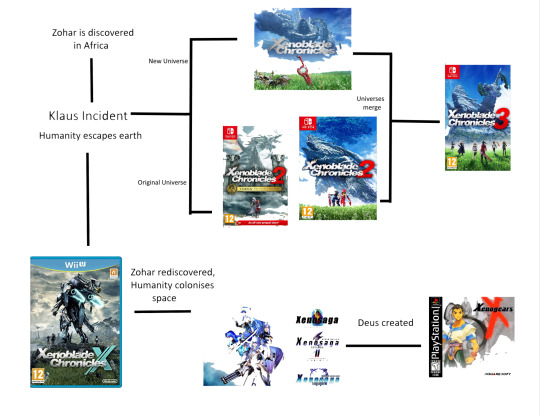
(Source: CobaltBuizel on Reddit)
Abiding by this timeline, a lot of stuff makes sense. The Zohar creates a timeline split, and within each timeline, it also creates a reality split. In the Blade timeline, it splits reality into a Matter Domain and an Antimatter Domain; while in the Saga Timeline, it splits it into a Real Numbers Domain and an Imaginary Numbers Domain. On top of that, there are infinitely many other universes parallel to the Xeno universes. There is only a single Upper Domain that exists above all of these, and each of these parallel universes has their own Zohar that acts as their link to the Uppdr Domain and to all other parallel universes.
Now, there's a few weird things with this. The Black Fog is obviously the Gnosis, but it's also pretty clearly connected to the Upper Domain somehow. The Telethia in Xenoblade X had to travel there through the Upper Domain, probably through Black Fog. Mira is probably Neo Jerusalem. And stupidest of all, the Nopon Archsage HAS to be connected to the Upper Domain somehow. This puts him at a power level rivaling Fei Fong Wong using Xenogears.
There's just one tiny little problem with this timeline.
We all know that Elma is pretty obviously meant to be KOS-MOS version 5.
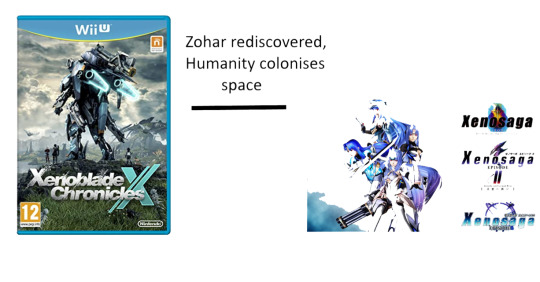
How?????
It's weird enough that KOS-MOS and Elma are both in Xenoblade 2, but we can assume that there's weird shenanigans with the Nopon Archsage and the Upper Domain.
But, uh. Unless I'm severely misunderstanding Xenosaga lore, it doesn't make any real sense at all for KOS-MOS version 5 to exist before the Xenosaga games happened. Even if we say she ISN'T version 5, it still doesn't make sense for her to exist in this way at this time in this place.
Now. It would make COMPLETE sense for her to be KOS-MOS version 5 if Xenoblade X happens between Xenosaga and Xenogears. And, though it would mean there's even more Upper Domain shenanigans, it makes even more sense for Xenoblade X lore if it takes place after Xenoblade 3.
But that kinda just.
Doesn't make any sense at all with Xenoblade 3 lore.
There's two possible paths for the futures of the Xenoblade 1 and 2 universes. Either they drift apart permanently, which makes sense; or somehow there's a bridge built between them that can safely link the worlds together, like what Melia, Nia, and Noah kinda imply during the ending.
If the universes drift apart, Xenoblade X might still make sense if it takes place way into the future of the Xenoblade 1 world. If the universes are linked together, it still makes sense in the same way.
So for now, we have to assume that Xenoblade X happens WAY after Xenoblade 3 and Elma is KOS-MOS version 5 sent through the Upper Domain, and it just so happens that a series of events EXTREMELY SIMILAR to Xenoblade X happened before Xenosaga in the other timeline. This also means that KOS-MOS version 5 was sent through the Upper Domain sometime before Xenogears, and came out in the Blade timeline WAY after Xenoblade 3, which we can assume happens around the same time as Xenogears.
#xenoblade#xenoblade 3#xenoblade chronicles#xenoblade chronicles 3#xeno series#xenoblade 2#xenogears#xenoblade 1#xenoblade 3 spoilers#xenoblade chronicles 1#xenoblade chronicles 3 spoilers#xenoblade chronicles 2#xenoblade chronicles x#xenosaga
187 notes
·
View notes
Note
Hello, I have some suggestions for your list
Xenogears: Grahf and Wiseman
Xenosaga: Gaignun Kukai and Dmitri Yuriev | Albedo and Jr. (Rubedo)
We didnt add those already? Thanks theyve been added!
We did xenogears as a full post a bit back that mentioned the Grahf situation, for some reason forgot to put them on the list X-X
#blog chatter#-points- fellow xenofan!!!#Yeah the whole urtv bodyhopping merry-go-round sure was a plural situation huh#They just let Jr keep bodysharing w/ Albedo too without ever following up on the fact hes just chilling in there in game iirc its v funny#the wording after that whole incident was very ambiguous#xenosaga spoilers#xenogears spoilers#forgot to add them despite binging both of those so thank u for reminding
1 note
·
View note
Text

Program Canaan
10 notes
·
View notes
Text
xeno* spoilers
it's fucking hilarious though that the idea that which games you end up in depends entirely on which ship(s) you follow. follow the Eldridge and end up in xenogears, follow the white whale and end up in xenoblade chronicles x, stay on earth and end up in xenoblade chronicles123, follow the rest of the fleet and end up in xenosaga. Like, the idea that it's all just, happening.
45 notes
·
View notes
Text
I finished Xenoblade Chronicles: Future Redeemed
All in all absolutely phenomenal experience. Truly a visionary and audacious way to end such a popular series. Thematically resonant through to the end and well earned in the resolution it goes for. Beyond this I'm going to put a read more, under which will contain spoilers for the entire Xeno- franchise. That means Gears, Saga Episodes I-III, Chronicles 1-3, and X. I have a lot of thoughts and plenty more marinating to do, but these are my initial impressions.
Somehow managing to connect all of the Xeno- series not to AUs but canonically the same Prime Earth, which contextually is Our Earth is RIDICULOUS in how he pulled it off. It feels truly organic to all of the stories *AND* doesn't contradict any of them! It even, seemingly, directly ties into the beginning of X with it being 'May 23rd, 2022'. Elma arrived on Earth in the early 2020s and I believe she's that blue dot we see flying onto the Earth at the end of the credits.
Smashing all of those different FTL/Outer Space Colonization projects into a single radio broadcast in the background of just one cutscene is truly remarkable. Just a few lines recontextualizes this man's entire career.
And also, to those in the know, it reveals that all three of them:
The Earthlife Colonization Project (Xenogears)
The Immigrant Fleet (Xenosaga)
and Project Exodus (Xenoblade X)
Occur due to Zohar related experiments gone horrifically wrong. Which we know from each series individually. But knowing that all of them stem from a single post-scarcity, conflict-free, truly equitable and globalized Earth, which nonetheless kept on trying different experiments with these godlike processors and all of them went awry is really interesting.
This game in particular very much focuses on the idea that advancement and power and control for their own sake are meaningless. If you don't have an idea behind it, if you don't want to make things the world tangibly better it's pointless.
Future Redeemed successfully ties every Xeno- game into this theme directly, no matter how subtle they are about it in their own content.
The Chronicles games happened solely because Klaus wanted to play God and make a new universe he would control, using The Zohar.
Gears happened because The Gazel Ministry wanted to create a creature that matched the Biblical God in terms of ability which they could control.
The Saga games happened because people wanted this power for transhumanism, to perfectly control the genes and births of every person, to ignore the realities of death and disease, but in doing so became so entrenched in making literal Designer Babies that it cuts off natural human diversity and reduces the people born to mere products and instruments shilled by different companies with different patents.
And all of these happened from The Zohar, a processor/machine mind that far outstrips anything humanity can believe. A thing which the humans of Earth only discovered by chance. Being meddled with purely out of avarice and hubris. The humans of that Earth didn't need any of those things. They'd already accomplished a perfect, post scarcity world. And that's why Alvis, a machine who's sole purpose is to be the logical arbiter between two other AI, when left to his own devices, decided going back to that would be best, no matter the cost.
He saw all of the tragedies in the three Chronicles settings that occurred solely due to Klaus' hubris and realized none of it would happen if these humans, the ones who've only known strife and difficulty and pain, had access to that post scarcity, conflict free, equitable world and beyond this, Takahashi buries the lede a little bit.
All of those previously mentioned projects to get humans off of earth. They're all cover ups by the Coalition Government of Earth. They're all touted as great advancements for human progress and potential but in actuality they're all just covering up massive, horrific, failures which would each result in the destruction of the Earth and its people. It's just Klaus' mistake had such immediate and tremendous consequences it couldn't be covered up.
Everything was destroyed in an instant. And we see, in Gears and Saga, that those decisions still ultimately do lead to an unimaginable amount of human suffering, just not on Earth. All they've done is ship off that suffering, literally, to some far reach of space.
Underpinning all of this is a distrust in the government and their motivations. A distrust for authority who claims they only want best for you.
Which is why Fei returns to living a quaint life.
It's why Shion and Kos-Mos return to their normal.
It's why Shulk refuses to become a god.
It's why Rex and Pneuma live simple lives.
And it's why Noah throws away the Sword of the End.
Each has the chance to become an ultimate authority, to have complete dominion over the lives of countless others, and they all give that up to just be...human. This franchise is truly something special. I cannot wait to see what comes next.
Please, Takahashi. Let us go back to Mira now.
Thank you, truly, @andawarmgeek, for sending me a download code out of the blue for Future Redeemed. This was an experience that I won't soon forget.
24 notes
·
View notes
Text
One thing I really love about Xenosaga 3 is that it finally lets Shion be the protagonist of her own story, which if you ask me was a long time coming. Full spoilers below.
Xenosaga Episode 1’s story is really good, and serves as excellent setup for the world and characters. But one complaint I had with it after finishing was Shion’s lack of agency. Don’t get me wrong, it sets Shion up as a character very well. We get a very clear idea of her personality. Her dynamics with KOS-MOS and Allen are well defined. We’re given glimpses into her past and her struggles that get us asking questions. She reacts to horrifying moments like Cherenkov becoming a Gnosis like a real person would, which lays the groundwork for the toll these events take on her, until she finally reaches her breaking point in Episode 3. She really is a good character.
That being said…she doesn’t really do much, if you ask me.
After being saved from the Woglinde by KOS-MOS, Shion is mostly strung along by the plot or else is mostly just along for the ride. The main ongoing plot of Episode 1, is the scramble for the Y-Data. Ziggy and MOMO are being chased by numerous factions who all want the Y-Data for their own reasons. Eventually, this leads to Albedo being hot on their heels, and it is his pursuit of MOMO and feud with Jr. that takes up most of the story. As a result, MOMO is arguably the most important character to Episode 1’s plot.
Shion joins in the fight to help her new friends sure, but she doesn’t have much stake in the plot of her own. She and Allen are just trying to get home to Second Miltia. The main goal that is specific to Shion comes during the Encephalon dive, where Febronia asks her to save Cecily and Cathe. This kind of gets forgotten about during the fight with Albedo but sure. Shion has a definitive goal now, one that piques the player’s interest about her past.
Unfortunately, Episode 2 kind of drops the ball here. Look. You don’t need me to tell you Episode 2 has its problems. Enough of the fandom dunks on the game already. And the fact that Jr. is basically the main character in 2 has been pointed out countless times. But Shion’s lack of screen time and agency here is REALLY glaring. The moment of payoff when Shion finds Cecily and Cathe at the Zohar is the one moment where the emotional core of 2’s story is really about her. And it should be horrifying. Shion was convinced she could find some closure over the horror of watching Febronia die, by fulfilling her last wish, saving her sisters to make up for what happened to Feb. And here they are, half dead fuel for the Zohar, who she can only offer a mercy kill. Good god, no wonder she breaks down…
Except, I’m taking a good amount of context from Episode 3. Shion’s history with Feb still hasn’t been clarified by this point in 2. This otherwise powerful moment lacks context. And outside of that, Shion is once again, just kind of here. We get to see her fraught relationship with Jin which is pretty interesting. And we get one really cool scene that demonstrates the bond between her and KOS-MOS (a bond which we really need to buy into for 3’s ending to land). But her role in the story is minimal and KOS-MOS gets it even worse. I really love Xenosaga’s story, world and cast. A lot of the character stuff with Jr., Jin, MOMO, Ziggy and ESPECIALLY Albedo is excellent. But poor Shion, who is supposed to be our main character has been treated like an afterthought for two games now.
Ok, I’ll stop here because it sounds like I’m giving Xenosaga a lot of crap so far. And that’s really unfair. As I’ve said, the story in 1 and (mostly) 2 is still great. But I need to give these criticisms as context to explain why I found Episode 3 so refreshing. Right from the start, we are squarely back in Shion’s point of view. And right of the bat, she’s leading the charge into Vector’s database. She’s actively doing things, in the thick of the action, and has her own motivations for doing what she does (which you unfortunately need Missing Year to fully understand but fair enough).
And from here on, I love everything about Shion’s story. I love how her bond with KOS-MOS develops, the way she draws strength and hope from KOS-MOS coming to terms with her identity, to believe she can build herself back up again too (seriously, Monolith, you can’t call KOS-MOS Shion’s ‘other half’ and not expect me to raise an eyebrow). I love how we finally get the full context of her backstory on Old Miltia. And the way the reveal is done, forcing her to completely relive her past trauma unable to change it, is gut-wrenching.
I love how the game has the nerve to let Shion genuinely screw up, and how her hardships have a painfully clear effect on her thinking. The game walks a really good balance between giving her room to be flawed and express her pain realistically, while still being willing to call her out when it goes too far and not giving her a free pass to just be needlessly awful. It’s used as the basis for really cathartic character growth. Everything from the reveal of her true role in Wilhelm’s plans, watching her break free of her toxic ex boyfriend, and finally finding closure and solace amongst her friends. And she tops it all of by landing the resident best boy.
Shion had suffered so much that she thought no one could ever understand what she’d gone through. That she could never receive genuine love, only pity. She doesn’t want to be left alone again, but she doesn’t want to be pitied either. This led her to see a kindred spirit in Kevin, someone who’d also experienced loss at a young age, who shared her passion for science and made her feel safe. So much so that it blinded her to what a manipulative scumbag he was. Joining Kevin in his plan alongside Wilhelm would represent Shion giving into her past suffering in the worst possible way, inflicting destruction on the whole universe out of some sick idea of retribution. Kevin embodies the toxic belief that because your life sucked, it justifies hurting other people out of a sense that they owe you something as a result. But after seeing the depth of her friends’ unconditional love for her (especially Allen and KOS-MOS), realising that she can still find people who understand her, Shion is finally able to see Kevin’s mindset for what it is, reject him, and save the universe. And that begins the process to her healing for real.
It’s just so refreshing that Episode 3 lets Shion’s character shine the way it does. There’s something so personal and engaging about her arc in the third game that’s really satisfying to watch unfold. It definitely took a while and I do still wish she’d been a little more of a focus in the first two games, but the payoff was so worth it.
#forgive my babbling#I just have a lot of feelings about episode iii#shion uzuki#xenosaga#xenosaga episode iii#character discussion#xenosaga spoilers
7 notes
·
View notes